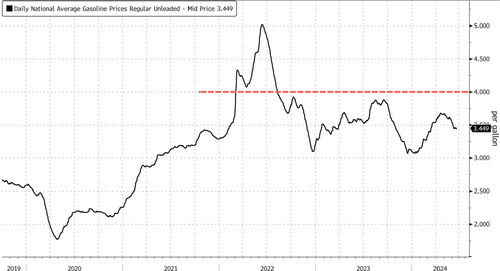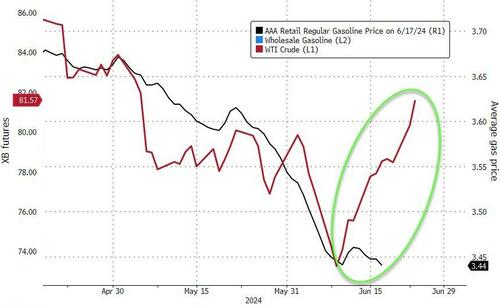
Gasoline prices at the pump could rise next week as a record 71 million Americans start their travel before early next month's Independence Day holiday. Prices peaked at $3.67 per gallon in mid-April and have recently dipped to $3.449 due to weakening demand.
New data from the American Automobile Association shows that 70.9 million folks will travel 50 miles or more from home during the Independence Day holiday travel period between June 29 and July 7. This is a 5% rise compared to 2023 and an 8% increase over 2019.
"With summer vacations in full swing and the flexibility of remote work, more Americans are taking extended trips around Independence Day," said Paula Twidale, Senior Vice President of AAA Travel, adding, "We anticipate this July 4th week will be the busiest ever with an additional 5.7 million people traveling compared to 2019."
Of the 71 million, a record 60.6 million people are expected to travel by car, and that's a 2.8 million increase from last year. This number also exceeds 2019 figures of 55.3 million.
AAA projects the national average for gasoline at the pump "will likely continue going down leading up to Independence Day" and "remain relatively stable until after Labor Day."
Prices are currently around $3.49, tumbling in recent weeks from $3.70 on the news the Biden administration is planning to drain the entire US Northeast gas reserve to push prices further down from the politically sensitive $4 level ahead of the presidential elections in November.
AAA noted, "An important caveat is hurricane season – underway now – which could affect gas prices should a storm negatively impact Gulf Coast oil production and refining centers."
In a recent note, we've pointed out that the La Nina weather phenomenon is expected to fuel an active Atlantic hurricane season. This could disrupt major US Gulf Coast refineries and ignite a gas price storm for the Biden camp.
Overall, gasoline demand is expected to remain soft despite an increasing number of Americans traveling more miles. According to RBC Capital Markets, gas station spending during the Memorial Day holiday was flat year over year.
On Tuesday, Phillips 66 CEO Mark Lashier told the audience at the JPMorgan conference that gasoline demand has not "hit its normal driving season stride," mostly due to a "bifurcated" economy that has depressed fuel demand among the working poor.
Patrick De Haan, head of petroleum analysis at GasBuddy, told Bloomberg that gas demand is running softer than last summer:
"We usually see demand peak for gasoline sometime in late July, so there's still some opportunity ... but it does look like we are running a little bit lower than last year."
Given these factors, gas prices are likely to remain stable around $3.5, if not start to rise due to higher WTI prices. The real concern for the Biden administration would be a tropical system taking out a Gulf Coast refinery.
Gasoline prices at the pump could rise next week as a record 71 million Americans start their travel before early next month’s Independence Day holiday. Prices peaked at $3.67 per gallon in mid-April and have recently dipped to $3.449 due to weakening demand.
New data from the American Automobile Association shows that 70.9 million folks will travel 50 miles or more from home during the Independence Day holiday travel period between June 29 and July 7. This is a 5% rise compared to 2023 and an 8% increase over 2019.
“With summer vacations in full swing and the flexibility of remote work, more Americans are taking extended trips around Independence Day,” said Paula Twidale, Senior Vice President of AAA Travel, adding, “We anticipate this July 4th week will be the busiest ever with an additional 5.7 million people traveling compared to 2019.”
Of the 71 million, a record 60.6 million people are expected to travel by car, and that’s a 2.8 million increase from last year. This number also exceeds 2019 figures of 55.3 million.
AAA projects the national average for gasoline at the pump “will likely continue going down leading up to Independence Day” and “remain relatively stable until after Labor Day.”
Prices are currently around $3.49, tumbling in recent weeks from $3.70 on the news the Biden administration is planning to drain the entire US Northeast gas reserve to push prices further down from the politically sensitive $4 level ahead of the presidential elections in November.
AAA noted, “An important caveat is hurricane season – underway now – which could affect gas prices should a storm negatively impact Gulf Coast oil production and refining centers.”
In a recent note, we’ve pointed out that the La Nina weather phenomenon is expected to fuel an active Atlantic hurricane season. This could disrupt major US Gulf Coast refineries and ignite a gas price storm for the Biden camp.
Overall, gasoline demand is expected to remain soft despite an increasing number of Americans traveling more miles. According to RBC Capital Markets, gas station spending during the Memorial Day holiday was flat year over year.
On Tuesday, Phillips 66 CEO Mark Lashier told the audience at the JPMorgan conference that gasoline demand has not “hit its normal driving season stride,” mostly due to a “bifurcated” economy that has depressed fuel demand among the working poor.
Patrick De Haan, head of petroleum analysis at GasBuddy, told Bloomberg that gas demand is running softer than last summer:
“We usually see demand peak for gasoline sometime in late July, so there’s still some opportunity … but it does look like we are running a little bit lower than last year.”
Given these factors, gas prices are likely to remain stable around $3.5, if not start to rise due to higher WTI prices. The real concern for the Biden administration would be a tropical system taking out a Gulf Coast refinery.
Loading…






